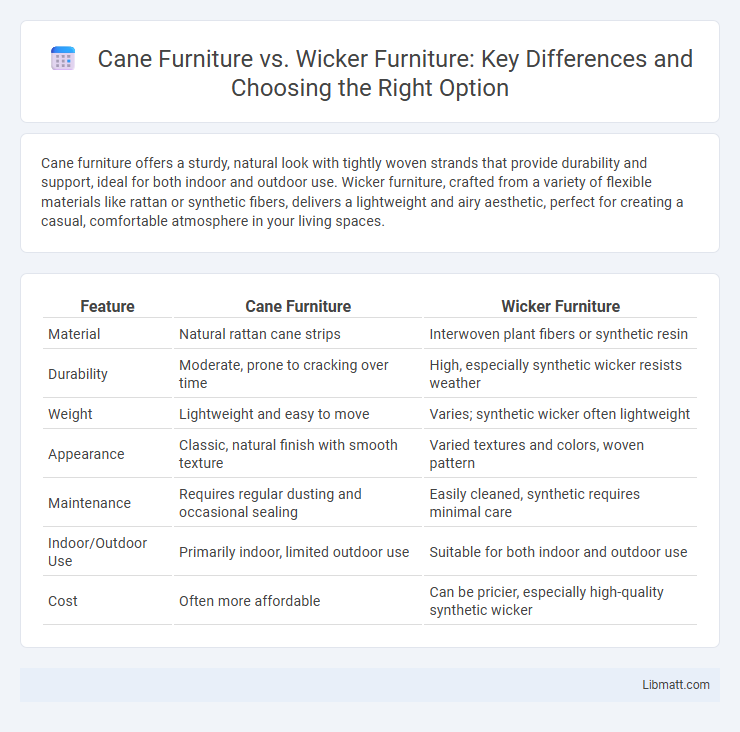Cane furniture offers a sturdy, natural look with tightly woven strands that provide durability and support, ideal for both indoor and outdoor use. Wicker furniture, crafted from a variety of flexible materials like rattan or synthetic fibers, delivers a lightweight and airy aesthetic, perfect for creating a casual, comfortable atmosphere in your living spaces.
Table of Comparison
| Feature | Cane Furniture | Wicker Furniture |
|---|---|---|
| Material | Natural rattan cane strips | Interwoven plant fibers or synthetic resin |
| Durability | Moderate, prone to cracking over time | High, especially synthetic wicker resists weather |
| Weight | Lightweight and easy to move | Varies; synthetic wicker often lightweight |
| Appearance | Classic, natural finish with smooth texture | Varied textures and colors, woven pattern |
| Maintenance | Requires regular dusting and occasional sealing | Easily cleaned, synthetic requires minimal care |
| Indoor/Outdoor Use | Primarily indoor, limited outdoor use | Suitable for both indoor and outdoor use |
| Cost | Often more affordable | Can be pricier, especially high-quality synthetic wicker |
Introduction to Cane and Wicker Furniture
Cane furniture features a natural material derived from rattan plant vines, known for its flexible yet sturdy qualities, making it ideal for crafting durable seating and decorative pieces. Wicker furniture describes a weaving technique using various materials such as bamboo, reed, or synthetic fibers, creating intricate patterns and lightweight structures. The distinct origins and craftsmanship methods of cane and wicker contribute to their unique aesthetics and functional applications in home decor.
What is Cane Furniture?
Cane furniture is crafted using the peeled bark of rattan vines, known for its durability, flexibility, and natural aesthetic. This type of furniture features a smooth, woven pattern that provides both strength and breathability, making it ideal for indoor and outdoor use. The lightweight yet sturdy nature of cane furniture ensures long-lasting comfort and style in various settings.
What is Wicker Furniture?
Wicker furniture is crafted by weaving natural or synthetic materials such as rattan, reed, bamboo, or resin into intricate patterns, creating lightweight and durable pieces ideal for indoor and outdoor use. Unlike cane furniture, which specifically uses the peeled outer bark of rattan vines, wicker emphasizes the weaving technique rather than the material itself, offering more design versatility. Your choice of wicker furniture ensures breathable comfort and stylish aesthetics, making it a popular option for patios, sunrooms, and casual living spaces.
Key Materials Used in Cane vs. Wicker
Cane furniture primarily uses rattan, a natural vine harvested from tropical regions, known for its durability and flexibility. Wicker furniture is crafted by weaving plant materials like willow, reed, bamboo, or synthetic fibers, offering diverse textures and styles. Your choice depends on the preferred aesthetic and the specific structural qualities of these materials.
Durability and Longevity: Cane vs. Wicker
Cane furniture, crafted from the inner bark of rattan plants, offers exceptional durability and can withstand heavy use due to its natural strength and flexibility. Wicker furniture, typically made from woven materials like rattan, bamboo, or synthetic fibers, varies in durability depending on the source material, with synthetic wicker providing superior resistance to weather and wear. Cane furniture generally boasts greater longevity in indoor settings, while synthetic wicker excels in outdoor environments due to its enhanced moisture and UV resistance.
Aesthetic Differences Between Cane and Wicker
Cane furniture features a smooth, uniform pattern with tightly woven strands that create a sleek, refined look, while wicker furniture exhibits a more intricate and textured appearance due to its varied weaving techniques using materials like rattan, bamboo, or synthetic fibers. The natural light tones of cane provide a minimalist, airy aesthetic ideal for modern or Scandinavian interiors, whereas wicker offers a rustic, cozy charm perfect for casual, coastal, or bohemian decor. Your choice between cane and wicker can significantly influence the room's ambiance, balancing between elegance and warmth.
Outdoor vs. Indoor Suitability
Cane furniture offers greater durability and resistance to outdoor elements, making it ideal for patios and garden settings, while wicker furniture excels in indoor environments due to its delicate, woven structure that can be easily damaged by moisture and sun exposure. Your choice should consider how weather-resistant materials and construction impact longevity and maintenance needs. Wicker's aesthetic charm enhances indoor spaces but requires careful protection if used outdoors.
Maintenance and Care Comparison
Cane furniture requires regular dusting and occasional polishing with a damp cloth to maintain its natural luster and prevent brittleness, while wicker furniture, often made from synthetic materials, is more resistant to moisture and easier to clean with mild soap and water. Both types benefit from avoiding prolonged exposure to direct sunlight and humidity to prevent fading and structural damage. Proper maintenance extends the lifespan of cane and wicker furniture, preserving their aesthetic appeal and durability in indoor and outdoor settings.
Price and Value Considerations
Cane furniture typically offers a higher price point due to the durability and craftsmanship involved, making it a long-term investment with strong value retention. Wicker furniture, often made from synthetic or natural materials, tends to be more affordable but may require more frequent replacement depending on exposure to weather conditions. When evaluating price and value, your choice should balance budget constraints with the desired longevity and maintenance level of the furniture.
Which is Better: Cane or Wicker Furniture?
Cane furniture offers a natural, durable material made from the outer bark of rattan, known for its lightweight yet sturdy construction, making it ideal for both indoor and outdoor use. Wicker furniture refers to the weaving technique applied to various materials such as rattan, bamboo, or synthetic fibers, providing versatile design options and enhanced weather resistance, especially in synthetic wicker. Choosing between cane and wicker furniture depends on preferences for authenticity and texture in cane or the broader material variety and maintenance ease found in wicker.
cane furniture vs wicker furniture Infographic

 libmatt.com
libmatt.com